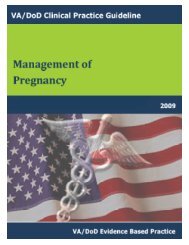DM Full Guideline (2010) - VA/DoD Clinical Practice Guidelines Home
DM Full Guideline (2010) - VA/DoD Clinical Practice Guidelines Home
DM Full Guideline (2010) - VA/DoD Clinical Practice Guidelines Home
You also want an ePaper? Increase the reach of your titles
YUMPU automatically turns print PDFs into web optimized ePapers that Google loves.
Version 4.0<br />
<strong>VA</strong>/<strong>DoD</strong> <strong>Clinical</strong> <strong>Practice</strong> <strong>Guideline</strong><br />
for the Management of Diabetes Mellitus<br />
J. Initiate/Adjust Therapy<br />
OBJECTIVE<br />
Achieve glycemic target goals by the most cost-effective and least invasive means.<br />
BACKGROUND<br />
Long-term outcomes of treatment of <strong>DM</strong> (i.e., microvascular complications) are related to the degree of glycemic<br />
control but not to the means used to achieve it (i.e., diet/exercise versus oral hypoglycemic agent versus insulin, or<br />
any known combination therapy). Based on this principle, therapy should be tailored to individual preferences,<br />
needs, and pragmatic considerations, such as cost and ease of compliance.<br />
RECOMMENDATIONS<br />
1. Individual treatment goals must be established with the patient based on the extent of the disease, comorbid<br />
conditions, and patient preferences.<br />
2. Institution of dietary modification and exercise alone is usually the appropriate initial management in<br />
patients with new onset type 2 diabetes, depending upon severity of symptoms, psychosocial evaluation,<br />
patient motivation, and overall health status. Encourage diet and exercise and lifestyle modifications.<br />
3. Use various approaches (e.g., individual or group, counseling, coaching, motivational interviewing) to<br />
promote healthful behaviors, such as healthful diet, adequate physical activity, and smoking cessation.<br />
4. If treatment goals are not achieved with diet and exercise alone, drug therapy should be initiated while<br />
encouraging lifestyle modifications.<br />
The concept of sequential treatment is commonly employed in clinical management of chronic diseases. The<br />
sequential steps for glycemic control therapy are summarized in Figure G1.<br />
DISCUSSION<br />
Non-Pharmacologic Therapy<br />
Each patient with newly diagnosed type 2 <strong>DM</strong> without markedly elevated HbA 1 c or symptomatic hyperglycemia<br />
should be offered trial of non-pharamcological therapy with diet and lifestyle modification prior to the use of<br />
medications. Lifestyle changes include diet (see Module M, Self-management and Education), exercise for at least<br />
30 minutes per day on most days of the week (as appropriate, after a detailed medical examination), weight loss if<br />
indicated, and smoking cessation. Limit alcohol to no more than 2 drinks per day for men and 1 drink per day for<br />
women (1 drink=12 ounces of beer, 5 ounces of wine, or 1.5 ounces of distilled spirits). Dietary modicficaion and<br />
exercise should be given at least a 3 month trial before drug therapy is started, unless fasting glucose >250 mg/dL or<br />
















